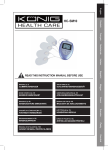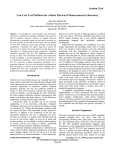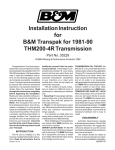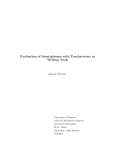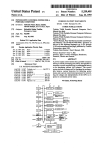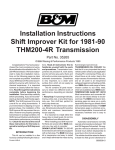Download T$IE
Transcript
US 20040119484A1 (19) United States (12) Patent Application Publication (10) Pub. No.: US 2004/0119484 A1 (43) Pub. Date: Basir et al. (54) CAPACITANCE BASED HUMAN TOUCH Jun. 24, 2004 Related US. Application Data ACTIVATION AND SWITCHING DEVICE (60) (76) Inventors: Otman A. Basir, Waterloo (CA); Vladimir Filippov, Kitchener (CA); J ean-Pierre Bhavnani, WaterdoWn (CA); Emil Breza, Bearnsville (CA); Kristopher Desrochers, Kitchener (CA); Fakhreddine Karray, Waterloo (CA) Provisional application No. 60/430,892, ?led on Dec. 4, 2002. Provisional application No. 60/404,018, ?led on Aug. 16, 2002. Publication Classi?cation (51) (52) Int. Cl? ................................................... ..G01R 27/26 Us. 01. ............................................................ ..324/680 (57) Correspondence Address: CARLSON, GASKEY & OLDS, RC. ABSTRACT A capacitance based human touch activation and switching device includes an electrode adjacent a hand contact area. 400 WEST MAPLE ROAD SUITE 350 The electrode is part of a capacitor and is connected to a detection device that monitors the capacitance. When a user BIRMINGHAM, MI 48009 (US) (21) Appl. No.: 10/643,159 hand is near the electrode, the capacitance increases. Based upon the change in capacitance, the device activates a sWitch, such as a vehicle horn, dorne light or other vehicle (22) Filed: Aug. 18, 2003 accessory. 27 FFSCILATOEY ________________ — _ _: I| ELECTRODEI l 34 ~ 54 ‘AL + fOUT REFERENCE WIRE I i| RREF I Cv l 242% f 48 50 52J T$IE___'____ 42 r- AC'DC _ — THRESHOLD i CONVERS'ON : _ _ _ _ 38 SWITCH | \ 40 _ 46 ' | I _ _ ___l Patent Application Publication ELECTRODE Jun. 24, 2004 Sheet 1 0f 3 27W [~20 38W DETECTOR $5 US 2004/0119484 A1 CIRCUIT SW'TCH [Fig-1 27 I- &CILATOR_ ________________ — — 7 I I I I : 38 DIFFERENTIAL RREF AMPLIFIER "31 , U u U I 42 46 | 2 + Cv I @ICEWIRE l 52J _ —-C REF f- OUT I “3'06 I~THRE$HOLD il \SWITCH CONVERSION I 40 . I T¥I _ _ _' _ 1.77;____________ _ _ J 60 27W 34 DETECTOR CIRCUIT [Fig-3 38x SW'TCH 58 W ACC 5s Patent Application Publication Jun. 24, 2004 Sheet 2 0f 3 US 2004/0119484 A1 W Capacitance 7 (Function of hand exposure) DETECTOR CIRCUIT SWITCH — SWITCH DETECTOR CIRCUIT DEVICE Patent Application Publication Jun. 24, 2004 Sheet 3 0f 3 DETECTOR C'RCUIT US 2004/0119484 A1 SWITCH DEVICE R @273 \/\/\/\/ F ELECTRODE 0 Am I 46a ' | MCU P‘ P @threshold ' I: \?rtual Capacitor Cv | Osc|||ating signal I N | Frequency 02 | 38 L_ 7:? _ _ _ _ _ _ _ _ _ _ _ . Ground IFI 2 - 8 it > %§ I . ;,,occupied“or Sw1tch I "on" I Output ______________ _' w_threshold_off E E E 6 8 CAPACITANCE (FUNCTION OF HAND EXPOSURE - HAND APPROACHING) IFig-Q _ _ __ _ _1 Jun. 24, 2004 US 2004/0119484 A1 CAPACITANCE BASED HUMAN TOUCH ACTIVATION AND SWITCHING DEVICE [0008] FIG. 1 is a high-level schematic of a capacitance based human touch activation and sWitching device. [0001] This application claims priority to US. Provisional Patent Application Serial No. 60/430,892 ?led Dec. 4, 2002 and US. Provisional Patent Application Serial No. 60/404, 018 ?led Aug. 16, 2002. FIG. 1 shoWing a more detailed schematic of one embodi ment of the detection circuit. BACKGROUND OF THE INVENTION [0002] The present invention relates to a capacitance based, human touch activation device especially for use in, but not limited to, automotive applications. Many accesso ries inside a vehicle are activated by a sWitch. Examples include interior lights, headlights, radio or other entertain ment systems, Windshield Wipers, horn, climate control, poWer WindoWs, poWer locks and air conditioning. Current technologies rely on contact based sWitches that can break or Wear out causing devices to be stuck in either an ON or OFF state. This can have adverse effects on the devices that are controlled by these sWitches. Atypical situation is When the mechanical sWitch controlling the horn fails in an alWays-on state. This can cause the driver of the vehicle and drivers of other vehicles in the vicinity to be distracted and can lead to traf?c accidents. The horn itself Will eventually fail leading to a costly replacement. [0003] Many of the sWitches in vehicles are also dif?cult to actuate under normal driving conditions. For eXample, actuating the dome light can be dif?cult While driving at night. Tiny sWitches are hard to ?nd by feel and often require [0009] FIG. 2 is the activation and sWitching device of [0010] FIG. 3 illustrates the use of the activation and sWitching device in a vehicle steering Wheel. [0011] FIG. 4 is a graph shoWing the operation of the activation and sWitching device of FIG. 2. [0012] FIG. 5 illustrates the use of the activation and sWitching device of FIG. 1 for controlling a vehicle dome light. [0013] FIG. 6 illustrates the use of the activation and sWitching device of FIG. 1 in a joystick. [0014] FIG. 7 illustrates the use of the activation and sWitching device of FIG. 1 in handlebars. [0015] FIG. 8 is the activation and sWitching device of FIG. 1 shoWing a more detailed schematic of a second embodiment of the detection circuit. [0016] FIG. 9 is a graph shoWing the operation of the activation and sWitching device of FIG. 8. DETAILED DESCRIPTION OF THE PREFERRED EMBODIMENTS the driver to look aWay from the road in order to ?nd them. [0017] A capacitance based human touch activation and sWitching device 20 is shoWn schematically in FIG. 1. [0004] In addition there are many devices, such as vehicles or tools that require maintaining proper hand con Generally, a detection circuit 27 measures capacitance Cv associated With an electrode 34 as it is changed by the tact during operation to ensure the safety of the operator. Current systems may have only emergency deactivation presence or absence of a user hand near the electrode. Based sWitches attached elseWhere on the device or may have upon the capacitance or upon changes in the capacitance of the electrode 34, the detection circuit 27 activates (sWitches depression sWitches attached to handlebars or joysticks to alloW activation of a device. Depression sWitches require eXtra pressure to be applied to the handlebars or joystick by on or sWitches off) a sWitch 38. More particularly, the detection circuit 27 measures or monitors the permittivity of an area adjacent the electrode 27. the operator and may become uncomfortable if operated for a sustained period of time. SUMMARY OF THE INVENTION [0005] The invention is a touch sensitive sWitching device intended to replace mechanical sWitches. Acapacitive sensor is capable of sensing human touch through a layer of non-conductive material. This eliminates the need for a hole or opening to be cut into the console Where the touch sensor is located. This alloWs the user to actuate a device such as a light simply by touching a designated location containing a sensing electrode. Furthermore, a capacitive based actuator does not affect the aesthetics of the interior of the vehicle. [0006] Use of a capacitive sensor integrated into a handle or grip area of a device Will eliminate the need for increased pressure during operation and Will increase comfort of the operator. The system can be designed to alloW activation of the device only While the operator is holding the control. Thus alloWing for emergency deactivation and ensuring safety of the operator if the control is released. BRIEF DESCRIPTION OF THE DRAWINGS [0007] Other advantages of the present invention can be understood by reference to the folloWing detailed descrip tion When considered in connection With the accompanying draWings Wherein: [0018] The formula for a parallel capacitor is C=eA/d Where C is capacitance, e is the permittivity, Ais area of the plates and d is the distance betWeen the plates. The values of these variables determine the capacitance of the capacitor. Therefore, a change in one or more of these variables causes a change in capacitance. The permittivity and the area of the plates are proportional to the capacitance While the distance betWeen the plates is inversely proportional to the capaci tance. This means that an increase in permittivity or area causes an increase in capacitance While a decrease in per mittivity or area causes a decrease in capacitance. The opposite is true for the distance betWeen the plates. An increase in the distance betWeen the plates causes a decrease in capacitance While a decrease in the distance betWeen the plates causes an increase in capacitance. The electrode 34 acts as one plate, While the surrounding environment acts as the second plate. [0019] One detection circuit 27 that could be used in the schematic of FIG. 1 is shoWn in FIG. 2. The detection circuit 27 includes a single differential ampli?er 40 and an AC-DC conversion circuit 42 to detect changes in the voltage, current and phase of the Waveform produced by the oscillator 44. A single threshold circuit 46 determines if these changes indicate the presence of an occupant. Each of the tWo inputs to the differential ampli?er 40 is connected to Jun. 24, 2004 US 2004/0119484 A1 one of a pair of arms in a bridge circuit 48. One arm of the bridge circuit 48 is used as a reference arm, including Rref, Cref and reference Wire 52. The other arm of the bridge circuit 48 contains the electrode 34 and Rocc. An oscillator 50 is connected to both arms. Each arm of the bridge circuit 48 is essentially a loW-pass ?lter. The reference arm of the bridge circuit 48 is tuned to have the same ?lter character istics as the arm that contains the electrode 34. The change surroundings. When the area in front of the steering Wheel 60 is empty, the medium adjacent the electrode 34 is air. Water has a higher permittivity than air and the human body consists of approximately 65% Water. Hence, putting a human body part betWeen the electrode and its surroundings Will increase the permittivity and, in turn, Will increase the capacitance betWeen the electrode 34 and its surroundings. The result is the capacitance of the system (Cv) increases in attenuation and phase of the Waveform passing through past the set threshold and activates the sWitch 38. In the the electrode arm of the bridge circuit 48 is measured With respect to the reference arm of the bridge circuit 48. Since both arms of the bridge circuit 48 are receiving the same event that the electrode 34 is moved to decrease or increase Waveform, it does not matter if the amplitude varies slightly. [0020] Noise rejection is accomplished by providing a second Wire 52 that is connected to the reference arm of the bridge circuit 48 and tWisted together With a Wire 54 that connects the electrode 34 to the bridge circuit 48. Since both Wires 52, 54 pick up the same noise, the noise is not ampli?ed because it is common to both arms of the bridge circuit 48 and both inputs to the differential ampli?er 40. All thresholds and signals in the device vary in proportion to the poWer supply voltage. As such, the device is tolerant to sudden changes in the supply voltage and Will function over a Wide range of supply voltages. Wire 54 may also be a coaXial cable in order to avoid noise and interference the distance betWeen plates, the relative change in the capacitance Will be small compared to the action of the addition of capacitance of a human body part, thus not accidentally triggering the system. [0023] FIG. 4 shoWs a plot of the DC output of the differential ampli?er 40 versus the value of the virtual capacitance Cv. Areas A and B represent the regions of the graph that correspond to OFF and ON. In the eXample Where the sWitch is used to activate a vehicle horn, Area A is the region of the graph that corresponds to OFF (a balanced bridge—no hand present) and Area B is the region of the graph that corresponds to ON (unbalanced bridge—hand present). Of course, the ON and OFF states might be reversed for other applications. The detection circuit 27 is tuned for a given environment as folloWs: The position of problems. the MINIMUM of the curve is set by the value of the [0021] The virtual capacitor Cv, created by electrode 34 is values are tuned so that the MINIMUM point on the curve connected in series With the resistor Rocc to form one arm of the bridge circuit 48. These are connected in parallel With the resistor Rref and the capacitor Cref Which form the reference arm of the bridge circuit 48. Each arm of the bridge circuit 48 is essentially a loW pass ?lter. The product RC determines the characteristic of each loW pass ?lter. When RC changes, the phase and the amplitude of output of the ?lter changes. The RC value for the reference loW pass ?lter is chosen so the bridge circuit 48 is balanced When no hand is present near the electrode 34. When there is a hand present near the electrode 34, Cv increases and the RC value changes in only one arm of the bridge circuit 48. The outputs of the tWo loW pass ?lters are no longer the same. The unbalance in the bridge circuit 48 is detected by amplifying the differences betWeen the tWo signals. The ampli?ed signal is an AC signal representing the voltage difference betWeen the tWo ?lters multiplied by the gain of the ampli?er 40. The difference in phase shifts betWeen the tWo ?lters is detected because the leading and lagging portions of each Waveform overlap each other causing a voltage differences betWeen theses signals. The AC signal is then passed through the AC-DC conversion circuit 42 to produce a DC signal that is then compared to a predetermined threshold in threshold detection circuit 46 to determine the presence or absence of a user hand. Based upon that determination, the detection circuit 46 sWitches on or off (depending upon the applica tion) an accessory 58. As Will be described beloW, the accessory could be any vehicle accessory, such as interior lights, headlights, radio or other entertainment systems, Windshield Wiper, horn, poWer WindoWs, poWer locks and climate control. [0022] FIG. 3 illustrates the electrode 34 from FIGS. 1 and 2 installed in a vehicle steering Wheel 60 for activating an accessory 58, such as a vehicle horn. The capacitance of the virtual capacitor Cv changes depending on the permit tivity of the medium betWeen the electrode 34 and its components in the bridge circuit Rocc, Rref and Cref. These occurs at the value of Cv that corresponds to no hand present. (Cbal). The sensitivity of the device to changes in the virtual capacitance Cv is tuned by changing the gain of the differential ampli?er and the predetermined threshold value Vthresh. Vthresh must be situated betWeen the MINI MUM of the curve and the saturation voltage of the differ ential ampli?er less a diode drop. Hysteresis may be imple mented by the threshold circuit 46, such that a higher threshold is required to sWitch the device from Area A to Area B, While a loWer threshold must be crossed to sWitch the device from Area B to Area A. [0024] FIG. 5 shoWs another implementation of the capacitive based actuation device 20 of FIG. 1 installed in a roof 70 of a vehicle near the dome light 72. In this case, the detection circuit 27 is con?gured in a toggle mode (for eXample, by a toggle circuit in the threshold circuit 46 (FIG. Each time the device is triggered the state of the dome light 72 is inverted. The eXtra capacitance introduced into the capacitance Cv associated With electrode 34 Will either activate or deactivate the dome light 72 depending on its initial state prior to the device being triggered. [0025] FIGS. 6 and 7 illustrate a third implementation of the capacitance based human touch activation and sWitching device 20 of the present invention for determining if an operator of a device 80 is maintaining proper hand contact to continue safe operation. The electrode 34 is mounted in or adjacent a user contact area, such as a user grip area or handle, such as a joystick 74 as shoWn in FIG. 6, handles 76 as shoWn in FIG. 7, or other hand grip or control devices. A second electrode 34a may optionally be used either to require both hands on the handlebars 76, or to require at least one hand on the handles 76. The sWitch 38 places the device 80 in a deactivated or disabled state until the operator’s hand or hands are in position, or signals an alarm indicating that the operator has released the joystick 74 or handles 76. The Jun. 24, 2004 US 2004/0119484 A1 device 80 may be a power device, such as a vehicle, power changed. Using this method, the control unit 46a can trigger tool, machinery or other device Where it Would be desirable an “on” signal if the rate of change is above a predetermined threshold. This technique can be used in application to determine if the electrode 34 Was stricken quickly or if the electrode 34 Was only brushed by accident. to disable the device if the use removes his hand from the user contact area, such as releasing a handle. [0026] In an alternate detection circuit 27a shoWn in FIG. 8, capacitance is used indirectly as the means of presence detection. The electrode 34 becomes a capacitor in an oscillator. The frequency at Which the oscillator functions is dependent on several parameters including the capacitance C. When no hand is present the system Will oscillate at a given frequency based on these parameters so long as they remain constant. When a hand is present, the C value increases. If, for example an RC oscillator is used, an increase in capacitance C results in a decrease in oscillating frequency. This phenomenon can be used to determine the presence of an occupant. Other oscillator con?gurations may have an output in Which an increase in capacitance results in an increase in frequency. [0027] A control unit 46a is used to measure the oscilla tor’s frequency and compare the incoming frequency to a set threshold frequency. When no hand is present, the oscillator operates at a ?xed frequency based on the capacitance and its surroundings. This knoWn frequency is used to tune the control unit’s 46a detection algorithm. A threshold is set on the control unit that Will serve to detect the presence of a hand When it is crossed. When the operator places his hand near the electrode 34, the increase in capacitance causes the oscillator frequency to change and cross the set threshold. When the control unit 46a detects the frequency has crossed the threshold, it outputs a signal indicating the presence of a hand. Adjusting the threshold and the surface are of the electrode can control the sensitivity of the device. The threshold determines the amount of change that is necessary to trigger the system. The threshold can be set to require contact With the electrode 34, or it may be set to values that only require the hand to be near the handlebar or joystick. This threshold must be tuned based on the particular appli cation and the surrounding environment. In addition, since the system uses capacitance, the surface area of the electrode plays a role in overall system’s sensitivity. The more surface area covered by the electrode, the more sensitive the system Will be. [0028] Preferably, the control unit 46a implements hys teresis With respect to the threshold frequency, as is illus trated in the graph of FIG. 9, to eliminate ?ickering of the output signal When the frequency is hovering around the threshold. In the RC oscillator, the operating frequency of [0031] The detection circuit 27a and control unit 46a can be used in any of the con?gurations described With respect to FIGS. 1, 3, 5, 6 and 7. [0032] In accordance With the provisions of the patent statutes and jurisprudence, exemplary con?gurations described above are considered to represent a preferred embodiment of the invention. HoWever, it should be noted that the invention can be practiced otherWise than as spe ci?cally illustrated and described Without departing from its spirit or scope. What is claimed is: 1. A user-activated sWitch comprising: an electrode forming part of a capacitor, a user contact area adjacent the electrode de?ning a permittivity of the capacitor; and a detection circuit measuring a capacitance of the capaci tor and activating a sWitch based upon the measured capacitance. 2. The user-activated sWitch of claim 1 Wherein the electrode is in a vehicle. 3. The user-activated sWitch of claim 2 Wherein the electrode is on a vehicle steering Wheel. 4. The user-activated sWitch of claim 2 Wherein the sWitch is for activating a vehicle horn. 5. The user-activated sWitch of claim 1 further including: a bridge circuit including the electrode, the bridge circuit being balanced When no user hand is detected near the electrode, the bridge circuit becoming unbalanced based upon the presence of a user hand near the electrode; and a differential ampli?er determining When the bridge cir cuit is unbalanced and activating the sWitch based upon Whether the bridge circuit is balanced. 6. The user-activated sWitch of claim 5 further including an oscillator exciting the bridge circuit. 7. The user-activated sWitch of claim 1 Wherein the sWitch is activated based upon a rate of change of the capacitance. 8. The user-activated sWitch of claim 1 Wherein the electrode is mounted adjacent a user manual contact area. 9. The user-activated sWitch of claim 1 Wherein the electrode is mounted adjacent a user hand grip area. 10. The user-activated sWitch of claim 1 Wherein the the oscillator must cross u)_threshold_on in order for the invention to output an “on” signal. u)_threshold_off is the frequency that must be crossed prior to outputting an “off” signal. These tWo thresholds can be tuned in the control unit. electrode is mounted adjacent a user hand contact area adjacent a user hand contact surface of a poWer device, the [0029] The systems utiliZing the detection circuit 27a of sWitch deactivating the poWer device When no user hand is detected near the electrode. FIGS. 8 and 9 can also function as a toggle sWitch: the control unit 46a can be set to continuously output an “on” signal once the frequency threshold has been crossed. The control unit 46a Will continue outputting the “on” signal even if the frequency ceases to cross the threshold. The control unit 46a Will then toggle the output to signal “off” if the frequency crosses the threshold once again. [0030] In addition, the control unit 46a can monitor the rate of change of the oscillator’s frequency. This alloWs the control unit 46a to determine hoW quickly the frequency has 11. The user-activated sWitch of claim 10 Wherein the user hand contact surface is adjacent a user hand grip area. 12. A method for determining a presence of a user hand including the steps of: a) measuring a change in permittivity of an area adjacent an electrode caused by the proximity of the user hand; and b) activating a sWitch based upon the change measured in said step a). Jun. 24, 2004 US 2004/0119484 A1 13. The method of claim 12 further including the steps of: 24. A vehicle horn sWitch comprising: c) measuring a rate of change in capacitance in said step an electrode mounted on a vehicle steering Wheel, the a); and d) activating the sWitch in said step b) based upon the rate of change measured in said step c). 14. The method of claim 13 Wherein a vehicle horn is activated based by the sWitch in said step d). 15. The method of claim 12 Wherein a vehicle accessory is activated by the sWitch in said step b). 16. The method of claim 12 Wherein a vehicle horn is activated based by the sWitch in said step b). electrode forming part of a capacitor, a capacitance of the capacitor changing based upon a presence or absence of a user hand adjacent the electrode; and a detection circuit measuring the capacitance of the capacitor and activating the horn based upon the mea sured capacitance. 25. The vehicle horn sWitch of claim 24 Wherein the detection circuit further includes: 17. The method of claim 12 Wherein the sWitch is a manual, user-activated sWitch. 18. The method of claim 17 Wherein the sWitch activates a vehicle accessory. 19. The method of claim 18 Wherein the vehicle accessory is a vehicle light. 20. The method of claim 18 Wherein the vehicle accessory is a vehicle horn. 21. The method of claim 12 Wherein said step b) further includes the steps of: c) enabling a device based upon the change in capacitance indicating that the hand is present; and d) disabling the device based upon the change in capaci tance indicating that the hand is not present. 22. The method of claim 21 Wherein the capacitance adjacent the electrode is adjacent a user manual contact area, such that the sWitch is activated in said step b) based upon the proXimity of the user hand to the user manual contact area. 23. The method of claim 22 Wherein the capacitance adjacent the electrode is adjacent a user grip area, such that the sWitch is activated in said step b) based upon the proXimity of the user hand to the user hand grip area. a bridge circuit including the electrode, the bridge circuit being balanced When no user hand is detected near the electrode, the bridge circuit becoming unbalanced based upon the presence of the user hand near the electrode; and a differential ampli?er determining When the bridge cir cuit is unbalanced and activating the horn sWitch based upon Whether the bridge circuit is balanced. 26. The vehicle horn sWitch of claim 24 Wherein the capacitor is part of an oscillator oscillating at a ?rst fre quency When no hand is present adjacent the electrode and at a second frequency different from the ?rst frequency When the hand is adjacent the electrode, the detection circuit activating the horn sWitch based upon the frequency of the oscillator. 27. The vehicle horn sWitch of claim 24 Wherein the capacitance of the capacitor is changed by a change in permittivity of a medium in the capacitor, the permittivity being changed by the presence or absence of the hand adjacent the electrode.








